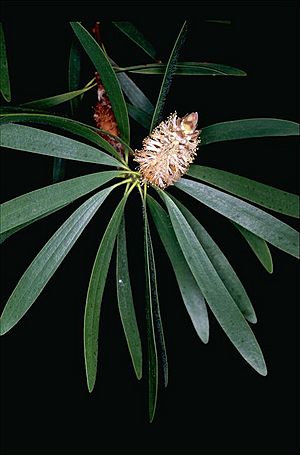Melaleuca cornucopiae facts for kids
Quick facts for kids Melaleuca cornucopiae |
|
|---|---|
 |
|
| Scientific classification | |
| Genus: |
Melaleuca
|
| Species: |
cornucopiae
|
Melaleuca cornucopiae is a special kind of shrub. It belongs to the Myrtaceae family, which includes plants like eucalyptus. This plant grows only in western Arnhem Land in the Northern Territory of Australia. It's famous for its unique flower spike. This spike looks like a horn and is covered with overlapping leaf-like parts called bracts. The flowers on this spike open one after another, starting from the bottom.
What it Looks Like
Melaleuca cornucopiae is a shrub that can grow up to 4 m (10 ft) tall. It has grey bark that feels like paper. Its leaves are stiff and grow one after another along the stems.
These leaves are 40–105 mm (2–4 in) long and 4–15 mm (0.2–0.6 in) wide. They are shaped like a narrow oval or ellipse. Each leaf has a long stem and a rounded tip. You can also see 3 to 7 clear lines, or veins, running along the leaf.
Its Unique Flowers
The flowers of this plant grow on a spike. This spike is usually found at the end of the branches. Even after the plant flowers, the branches keep growing. The flowers open one by one, starting from the bottom of the spike.
Each spike has 10 to 50 groups of flowers, with three flowers in each group. The petals are small, about 1.9–2.2 mm (0.075–0.087 in) long. They fall off as the flowers open. The white stamens, which are the parts that hold pollen, are grouped into five bundles. Each bundle has 5 or 6 stamens.
This plant usually flowers during the summer months. After the flowers, small, woody seed pods appear. These pods are called capsules. Each capsule is about 3.4 mm (0.13 in) long and holds the seeds.
Naming the Plant
The scientific name Melaleuca cornucopiae was first officially given by a botanist named Norman Byrnes. He described it in 1984 in a scientific journal called Austrobaileya.
The second part of its name, cornucopiae, comes from the word "cornucopia." This word means "horn of plenty" and refers to the horn-like shape of the flower spike.
Where it Grows
This special melaleuca plant is found only in western Arnhem Land. It grows in mixed woodlands, which are forests with different types of trees. You can find it growing in sandy soils on sandstone rock formations.

